Buenos Aires – It began innocently enough, with an e-mail, as things often do these days. It was a few days after my announcement about opening up Casa SaltShaker for dinners. I’d met Alberto in November when I took him up on a free tour he was offering. We’ve kept in touch, so receiving an e-mail from him was not completely out of the ordinary. A two week conversation ensued, excerpted below:
Alberto: I have been discussing the possibility of having dinner at your place with three Americans who are coming in a couple of weeks. The Americans have chosen you over MAAT, which was another alternative I gave them. The Americans are hunters. If they bring “perdices”, do you think you could cook them? I would like to approve the menu. Would that be possible?”
Me: “In terms of perdices, yes, I can cook partridges, no problem. I’m delighted that they want to eat here rather than at Maat, much as I like Maat. In terms of menu approval, I guess that depends what you mean. I definitely have my own style of cooking that’s fairly “New York” in execution.”
Alberto: “Of course what I meant was could I approve the contents of the menu, not the style. Say, for instance, if you were going to give us apples for dessert, I hate apples, so that would not be a good idea, from MY point of view. Besides, more jokingly, I wouldn’t DREAM of interfering with any chef’s style, particularly not with yours.”
Me: “You’d be surprised how many people do though, so not so much for your perspective as a fellow profesional, but I was more concerned about the tourists themselves – I’ve gotten requests from people already to do things like “can you cook this dish from my mother’s recipe and serve it to my friends?” – which, in general, I’d rather not do, at least not at home, though, I offer to drop it off at their home and let them claim they cooked it!”
Alberto: “They have not confirmed yet that they can bring partridges, because they are predominantly duck hunting. I already told them that the partridges should be cleaned and kept cold, until they bring them. However, I repeat, I don’t have a final answer about that, yet.” [Note: Somewhere in here they decided against bringing their own birds, though I can’t find that e-mail.]
Alberto: “Try to find a dessert I’ll like, such as Postre Rogel, or some kind of local thing with Dulce de Leche. On second thought, how would you feel about Crepes Suzette? Let me know.”
Me: “I’ll come up with an interesting dulce de leche based dessert for you!”
Alberto: “Any news about that dulce de leche based dessert?”
Me: “Trust me, it’ll be something good.”
Alberto: “Are there any good heladerías near your home?”
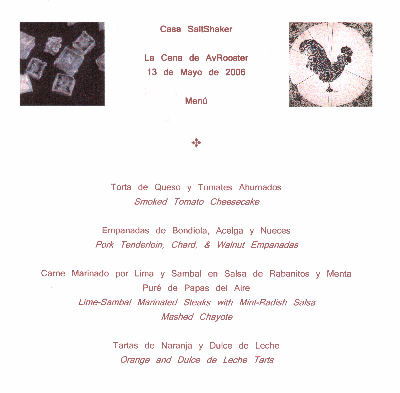
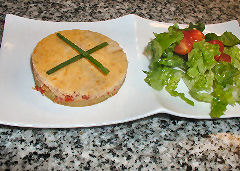 I know a few of you are looking at the menu going “Smoked Tomato Cheesecake? Is he insane?” In fact, the guests all later admitted that they’d had the same thought but were willing to trust me on this one. But remember, the day before I did a menu out of chocolate. This is actually one of my personal favorites – a “signature” dish if I have one – something I used to do in bite-size when catering as an hors d’oeuvre. Even served this at my dad’s 60th birthday party which I catered for him. But I understand the reaction – most folks, and especially here, think of cheesecake as strictly a dessert. This has a shortbread crust that is spiced with things like curry powder, chili powder, turmeric, cayenne pepper, and paprika. The cheese part is a pretty classic baked cheesecake recipe (not “New York style”, more of old style European), sans the sugar and vanilla, and flavored with chopped sun-dried tomatoes, marjoram, smoked salt, and lemon.
I know a few of you are looking at the menu going “Smoked Tomato Cheesecake? Is he insane?” In fact, the guests all later admitted that they’d had the same thought but were willing to trust me on this one. But remember, the day before I did a menu out of chocolate. This is actually one of my personal favorites – a “signature” dish if I have one – something I used to do in bite-size when catering as an hors d’oeuvre. Even served this at my dad’s 60th birthday party which I catered for him. But I understand the reaction – most folks, and especially here, think of cheesecake as strictly a dessert. This has a shortbread crust that is spiced with things like curry powder, chili powder, turmeric, cayenne pepper, and paprika. The cheese part is a pretty classic baked cheesecake recipe (not “New York style”, more of old style European), sans the sugar and vanilla, and flavored with chopped sun-dried tomatoes, marjoram, smoked salt, and lemon.
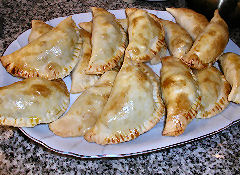 Here’s a question for the Argentine folk who read the blog. Why aren’t there pork empanadas? There are empanadas made from beef, chicken, lamb, various fish and shellfish, cheeses, and several different vegetables. But I’ve never seen, nor heard of, Pork Empanadas here (other than ham). I know they exist in Spain, especially grilled pork versions, they exist in Mexico, where barbecued pork and chipotle fillings are popular in many places for Cinco de Mayo. But, seemingly, not in Argentina. And it’s not like Argentines don’t eat pork.
Here’s a question for the Argentine folk who read the blog. Why aren’t there pork empanadas? There are empanadas made from beef, chicken, lamb, various fish and shellfish, cheeses, and several different vegetables. But I’ve never seen, nor heard of, Pork Empanadas here (other than ham). I know they exist in Spain, especially grilled pork versions, they exist in Mexico, where barbecued pork and chipotle fillings are popular in many places for Cinco de Mayo. But, seemingly, not in Argentina. And it’s not like Argentines don’t eat pork. 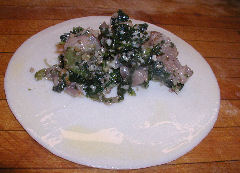 So, my version – pork sauteed with red onion, garlic, chard, finely ground walnuts (I wanted to use pecans as the flavor is a slightly better match, but the stores in the neighborhood were all out), marjoram, salt, and crushed green peppercorns. Once the filling was cooled, it was a relatively simple matter of making the empanadas themselves (I did NOT make my own empanada dough, there are too many places here where one can buy ready made and quite good empanada dough), and brushing them with a light egg wash to get that shiny glow.
So, my version – pork sauteed with red onion, garlic, chard, finely ground walnuts (I wanted to use pecans as the flavor is a slightly better match, but the stores in the neighborhood were all out), marjoram, salt, and crushed green peppercorns. Once the filling was cooled, it was a relatively simple matter of making the empanadas themselves (I did NOT make my own empanada dough, there are too many places here where one can buy ready made and quite good empanada dough), and brushing them with a light egg wash to get that shiny glow.
Now, I should point out that with things a little crazier than normal, I completely forgot to take photos during the dinner. I’d taken them during the prep process, here and there, but didn’t remember to take any during the actual service. So, unfortunately, I don’t have a picture of the main course, the steak. I had enough extra of the other dishes for us to eat later that I could recreate them and take the photos, but the steak is lost to all time. However, it looked like a steak on a plate, with a scoop of salsa next to it, and a pool of vegetable puree. 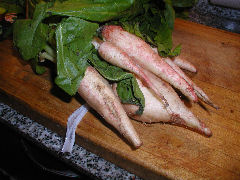 This picture, however, are strange radishes that I found. I didn’t find them intentionally, I wasn’t paying close attention a couple of days ago and thought I was buying a bunch of parsnips for a chicken soup. When I started to cut one up I realized my mistake, and also realized the leaves are completely wrong for a parsnip. But, since I had the radish salsa planned, I decided to use these instead of regular red radishes. They were a little bit more amargo than regular radishes, so I picked up a small daikon when I was in Chinatown the other day to balance it off a little. The salsa’s pretty simple, and one I’ve used many times with steak – chopped radishes, green onion, mint, olive oil, salt and pepper. The cool, freshness of the mint balances the spice of the radishes nicely, at least for my palate – and since almost everyone ate it all last night, I’m guessing it was true. The steaks were marinated for the day in a spicy marinade of sambal and lime juice.
This picture, however, are strange radishes that I found. I didn’t find them intentionally, I wasn’t paying close attention a couple of days ago and thought I was buying a bunch of parsnips for a chicken soup. When I started to cut one up I realized my mistake, and also realized the leaves are completely wrong for a parsnip. But, since I had the radish salsa planned, I decided to use these instead of regular red radishes. They were a little bit more amargo than regular radishes, so I picked up a small daikon when I was in Chinatown the other day to balance it off a little. The salsa’s pretty simple, and one I’ve used many times with steak – chopped radishes, green onion, mint, olive oil, salt and pepper. The cool, freshness of the mint balances the spice of the radishes nicely, at least for my palate – and since almost everyone ate it all last night, I’m guessing it was true. The steaks were marinated for the day in a spicy marinade of sambal and lime juice.
Indonesians make a range of relishes, based on chilies, called sambals. Some are fiercely hot because the chili seeds have been left in; all are highly aromatic. Possibly the most basic of sambals is the sambal oelek, a pounded paste of fresh red chilies, salt, and brown sugar. You can even buy sambal oelek in most asian markets. For marinating purposes like this, I prefer to make my own. The marinade was a liquified mixture of the juice of six limes, six fresh red chilies (seeded, I didn’t want to go overboard on the heat), 1 tablespoon of salt, and 1 tablespoon of brown sugar. The steaks, bife de chorizos, were marinated for about 8 hours in the mixture.
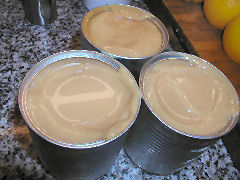 I’d agreed to provide Alberto with his requested dulce de leche, even if I wasn’t going to tell him what I was going to make from it. I was inspired a bit by that extraordinary orange custard tart I had a week or two ago at Il Matterello. Step one, of course, was to make the dulce de leche. Yes, make it. I have yet to find a commercial one that isn’t just over-the-top cloyingly sweet, not to mention tasting a trifle, well, commercial – after all, they add things to them to stabilize them for sitting on shelves in supermarkets. And the really good artesanal ones are outrageously expensive. This is going to sound like a joke, but it’s not, and a few minutes’ online research will show you I’m not making this up. Buy some cans of sweetened condensed milk.
I’d agreed to provide Alberto with his requested dulce de leche, even if I wasn’t going to tell him what I was going to make from it. I was inspired a bit by that extraordinary orange custard tart I had a week or two ago at Il Matterello. Step one, of course, was to make the dulce de leche. Yes, make it. I have yet to find a commercial one that isn’t just over-the-top cloyingly sweet, not to mention tasting a trifle, well, commercial – after all, they add things to them to stabilize them for sitting on shelves in supermarkets. And the really good artesanal ones are outrageously expensive. This is going to sound like a joke, but it’s not, and a few minutes’ online research will show you I’m not making this up. Buy some cans of sweetened condensed milk. 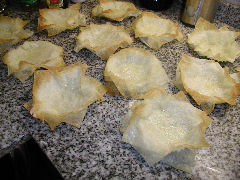 Put them in a large pot (unopened!) and fill with cold water that covers the cans by about 7-8″ – you need water pressure above the cans to stop them from blowing up. Bring to a boil over medium heat and then turn the heat down to very low, to keep just a bare simmer going. Let them simmer for 3½-4 hours. Less and the dulce de leche won’t be done, you’ll have caramel soup, more and it gets too dark and tastes slightly burnt. Turn off the heat, and let them cool in the water. When cool, open and enjoy. For presentation, I decided to do something slightly different, and picked up some phyllo dough. I’m not going to get into the intricacies of working with phyllo, but I like the way it ends up when making tart shells – a bit freeform.
Put them in a large pot (unopened!) and fill with cold water that covers the cans by about 7-8″ – you need water pressure above the cans to stop them from blowing up. Bring to a boil over medium heat and then turn the heat down to very low, to keep just a bare simmer going. Let them simmer for 3½-4 hours. Less and the dulce de leche won’t be done, you’ll have caramel soup, more and it gets too dark and tastes slightly burnt. Turn off the heat, and let them cool in the water. When cool, open and enjoy. For presentation, I decided to do something slightly different, and picked up some phyllo dough. I’m not going to get into the intricacies of working with phyllo, but I like the way it ends up when making tart shells – a bit freeform.
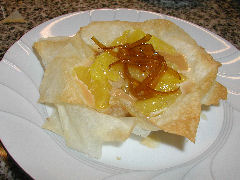 I think Alberto was reasonably happy with my surprise dulce de leche dessert. I know the host of the evening and his friends were, because they kept raving about it. In final execution it was pretty simple – the phyllo tart shells, filled with a generous dollop (¼ cup or so) of dulce de leche, topped with orange supremes (orange segments without the skin – not hard to do – here’s a great photo essay, step-by-step on how to do it), and candied orange peel (also quite easy, though a trifle time-consuming) – and then since the oven was still hot from empanada baking and finishing off two of the steaks that were requested well-done, I stuck them in the oven to warm up, which also helps the dulce de leche seem less cloying!
I think Alberto was reasonably happy with my surprise dulce de leche dessert. I know the host of the evening and his friends were, because they kept raving about it. In final execution it was pretty simple – the phyllo tart shells, filled with a generous dollop (¼ cup or so) of dulce de leche, topped with orange supremes (orange segments without the skin – not hard to do – here’s a great photo essay, step-by-step on how to do it), and candied orange peel (also quite easy, though a trifle time-consuming) – and then since the oven was still hot from empanada baking and finishing off two of the steaks that were requested well-done, I stuck them in the oven to warm up, which also helps the dulce de leche seem less cloying!
Them is three lucky hunters, Dan. Extremely fascinating menu. I’m curious to know what they drank with dinner.
1 bottle of Don Cristobal 1492 Verdelho, 2005; 2 bottles of Sur de los Andes Bonarda, 2004; both from me, and 1 bottle of Luigi Bosca Malbec 2004 that one of them brought as a gift for the host.
Oh, and one of the guests gave me a delightful (soon to be drunk) bottle of Angelica Zapata Malbec Alta 2001!
Hi Dan,
Again, thanks for the wonderful dinner. I hope you enjoy that bottle of wine. That is one of my favorites! It was nice meeting you. As you know I’ve been a fan of the site for a while. Keep up the good work.
Cheers,
Mike
Aloha Dan,
Yep, as mentioned we were three lucky hunters. It was so nice to get a home prepared gourmet dinner in such a warm and friendly setting. We felt lucky to be able to have been in Bs As during the launch of Casa Saltshaker. You told us about each serving as they were presented which was great, but reading about the individual ingrediants and the time spent for such a dinner was truly special. The wines were wonderful, and sorry the steaks were consumed so quickly…lol
Regards,
Tom
Glad you guys enjoyed it! It was a pleasure to have you here, and thank you for including me in the conversation at the end of the dinner. I do tend to get bored hanging out in the kitchen after the food is done with nothing to do. Especially as Henry’s niece cleaned all the dishes as she brought them back in! I didn’t even have cleanup to do!
[…] I nearly don’t want to comment on this feeble excuse for a flan. Advertised as a coconut flan topped with dulce de leche and a puree of red fruits, it was, well, to be kind, a reinterpretation. A tall, gritty, almost coconut flavored pudding, with a density that approached saltwater taffy, it bore minimal resemblance to the simple, classic dish it was called. The dulce de leche? Remember my little demo of how to make it the other day? Clearly they erred on the undercooked side – this was a runny caramel syrup. They got the fruits right, that squiggle of red was the only thing on the plate worth eating. […]
[…] Dinner last night was oriented around Argentine classics, though my own versions of them. I decided to make a duo of empanadas. For the first, I braised osso buco along with diced batatas in red wine, orange juice, crushed Chinese five spice, and mustard seeds – more or less combining the flavors from the main course on my English Renaissance dinner last month. For the second empanada I recreated the pork, walnut and chard versions I made in an earlier menu. Two days before the dinner, the hostess got back to me to let me know that one of the young ladies attending is semi-vegetarian (she eats fish). On arrival, it turned out another guest keeps semi-kosher, so fish and vegetables for him as well. I like to plan for things like that, so there’s always something in the refrigerator… For their empanadas I parboiled some diced batatas and then sauteed them with radicchio, garlic, orange peel, and mustard seeds (this turned out to be my favorite empanada of the evening). For the other, I sauteed some fresh white and brown mushrooms with leeks and thyme. It was good, but I think it needs some work – maybe some wild mushrooms thrown into the mix. […]
[…] Make dulce de leche – two cans worth. When cool, spoon over the top of the cupcakes in a bowl. […]
[…] additions. Two different takes on the two nights of a chocolate and salted caramel tart. First I made dulce de leche. The first night I used a chocolate cookie crust (crushed chocolate cookies with brown sugar and […]